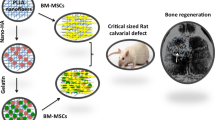Abstract
From the material point of view, the extracellular matrix (ECM) of bone is a natural nanocomposite consisting of an organic matrix (mainly collagen) and inorganic nanofillers (bone apatite) which are inserted in a parallel way into the collagen fibrils. For human bone tissue repair or regeneration, nanocomposites consisting of a biodegradable polymer matrix and nano-sized fillers such as bioactive ceramics or glasses, which mimic the hierarchical structure of bone, are considered a promising strategy. Combining living cells with biodegradable materials and/or bioactive component(s), the concept of tissue engineering first elucidated in the early 1990s represented a paradigm shift from tissue grafting, with autografts being the gold standard, or even completely from prosthesis implantation. In scaffold-based tissue engineering, scaffolds play an important role for tissue regeneration. Currently, acellular scaffolds with or without biomolecules such as growth factors are considered as an effective strategy for certain tissue repair due to their relatively low costs and easier process to gain surgeons’ acceptance and regulatory approval. In the current study, integrating an advanced manufacturing technique, nanocomposite material and controlled delivery of growth factor to form multifunctional tissue engineering scaffolds was investigated. Three-dimensional, osteoconductive and totally biodegradable calcium phosphate (Ca-P)/poly(hydroxybutyrate-co-hydroxyvalerate) (PHBV) nanocomposite scaffolds with customized architecture, controlled porosity and interconnecting pores were designed and fabricated using selective laser sintering (SLS). The surface of nanocomposite scaffolds was modified with gelatin and then heparin, which facilitated the incorporation of a growth factor, recombinant human bone morphogenetic protein-2 (rhBMP-2). Experimental results demonstrated the effectiveness of this strategy in guiding the osteogenic differentiation of mesenchymal stem cells. Together with osteoconductive nanocomposite material and controlled growth factor delivery, the use of SLS technique to form complex scaffolds provides a promising route towards individualized bone tissue regeneration.
Similar content being viewed by others
References
V. Mourino and A.R. Boccaccini, J. R. Soc. Interface 7, 209 (2010).
K. Seunarine, N. Gadegaard, M. Tormen, D. O’Meredith, M. O’Riehle and C.D.W. Wilkinson, Nanomedicine 1, 281 (2006).
W.B. Wan and P.F. Shi, Artif. Organs 34, 339 (2010).
D.W. Hutmacher, M. Sittinger, M.V. Risbud, Trends Biotechnol. 7, 354 (2004).
M.W. Naing, C.K. Chua, K.F. Leong and Y. Wang, Rapid Prototyping J. 11, 249 (2005).
J.T. Rimell and P.M. Marquis, J. Biomed. Mater. Res. 53, 414 (2000).
F.E. Wiria, K.F. Leong, C.K. Chua and Y. Liu, Acta Biomater. 3, 1(2007)
R.L. Simpson, F.E. Wiria, A.A. Amis, C.K. Chua, K.F. Leong, U.N. Hansen, M. Chandraselkaran and M.W. Lee, J. Biomed. Mater. Res. Part B 84B, 17 (2008).
B. Duan, M. Wang, W.Y. Zhou and W.L. Cheung, Appl. Surf. Sci. 255, 529 (2008).
B. Duan, M. Wang, W.Y. Zhou, W.L. Cheung, Z.Y. Li and W.W. Lu, Acta Biomater. 6, 4495 (2010).
W.Y. Zhou, S.H. Lee, M. Wang, W.L. Cheung and W.Y. Ip, J. Mater. Sci.-Mater. Med. 19 2535, (2008).
V. Karageorgiou and D. Kaplan, Biomaterials 26, 5474 (2005).
B. Duan and M. Wang, Polym. Degrad. Stabil. 95, 1655 (2010).
H. Petite, V. Viateau, W. Bensaid, A. Meunier, C. de Pollak, M. Bourguignon, K. Oudina, L. Sedel and G. Guillemin, Nat. Biotechnol. 18, 959 (2000).
M.D. Weir and H.H.K. Xu, J. Biomed. Mater. Res. Part A, 94A, 223 (2010).
O. Jeon, S.W. Kang, H.W. Lim, J.H. Chung and B.S. Kim, Biomaterials 27, 1598 (2007).
H.J. Chung, H.K. Kim, J.J. Yoon and T.G. Park, Pharm. Res. 23, 1835 (2006).
J.A. Beamish, L.C. Geyer, N.A. Haq-Siddiqi, K. Kottke-Marchant and R.E. Marchant, Biomaterials 30, 6286 (2009).
L. Chen, Z.Q. He, B. Chen, M.J. Yang, Y.N. Zhao, W.J. Sun, Z.F. Xiao, J. Zhang and J.W. Dai, J. Mater. Sci.-Mater. Med. 21, 309 (2010).
L. Zhao, G. Li, K.M. Chan, Y. Wang and P.F. Tang, Calcif. Tissue Int. 84, 56 (2009).
T. Date, Y. Doiguchi, M. Nobuta and H. Shindo, J. Orthop. Sci. 9, 503 (2004).
Author information
Authors and Affiliations
Corresponding author
Rights and permissions
About this article
Cite this article
Wang, M., Duan, B. Nanocomposite Scaffolds for Bone Tissue Engineering: Design, Fabrication, Surface Modification and Sustained Release of Growth Factor. MRS Online Proceedings Library 1301, 99–110 (2011). https://doi.org/10.1557/opl.2011.470
Published:
Issue Date:
DOI: https://doi.org/10.1557/opl.2011.470




